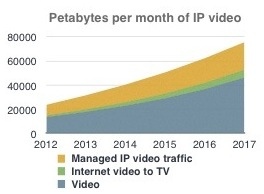
Source: Cisco VNI 2012-2017
By 2017 Internet protocol video traffic will triple worldwide, according to Cisco’s latest Visual Networking Index (VNI). It’s an annual estimate of how Internet and Internet protocol traffic will grow over the coming five years.
IP video traffic totalled 24,000 petabytes a month during 2012 and is projected to grow to 76,000 petabytes a month in 2017.
The share of Internet protocol video delivered inside a walled garden will gradually decline, although like everything else it will continue to increase in absolute terms. In 2012, Cisco estimates that video delivered to subscribers directly from their service providers accounts for 37% of IP video consumption. But by 2017, that figure will drop to 30%.
The study does not predict much of a shift towards over-the-top Internet video delivery to television sets, however. By Cisco’s reckoning, 6% of IP video went over the public Internet to television sets, a number that’s expected to climb to 9% in five years.
The biggest relative growth will come from people watching video on other types of devices – computers, tablets, phones and everything else except televisions – via the Internet. That type of usage is expected to grow from 57% of total IP video traffic in 2012 to 61% in 2017.
Cisco’s VNI is a mash up of data collected from various sources and projections developed by several research houses. To a certain extent, it’s a consensus view of where Internet/Internet protocol traffic patterns are headed.
I don’t think it’s getting the TV/non-TV split right, but it’s becoming largely a matter of semantics. It’ll matter less five years down the line as the innards of various kinds of devices start to look more and more alike.
